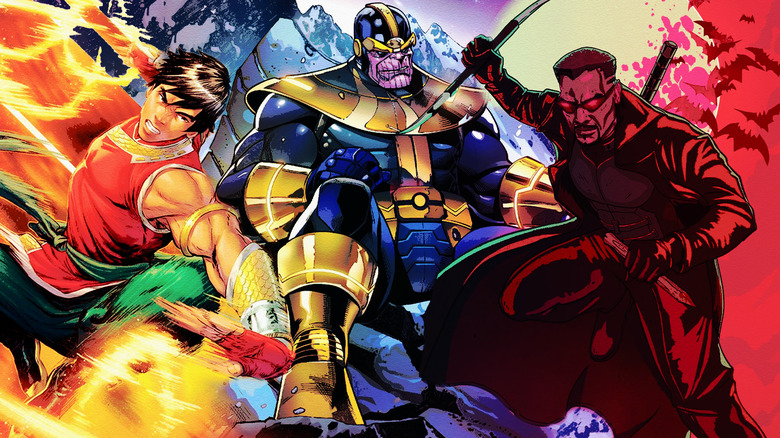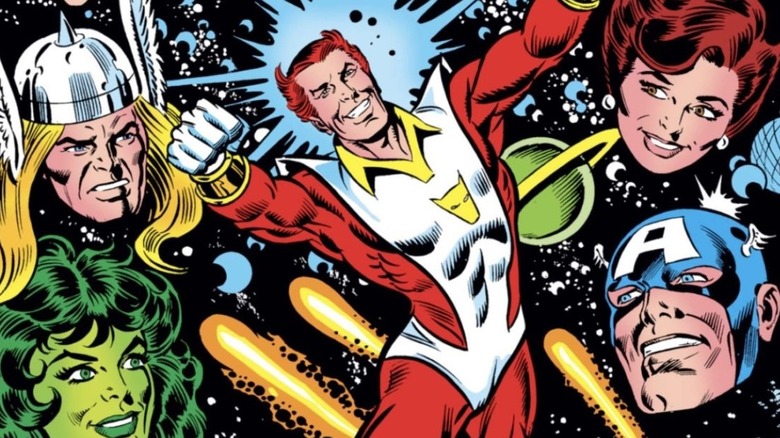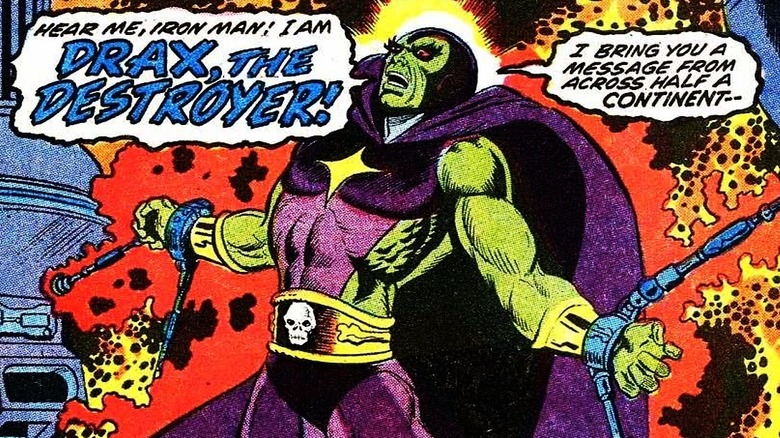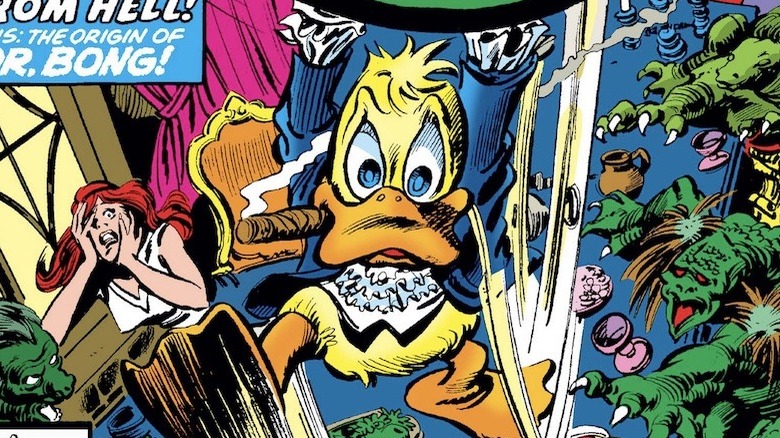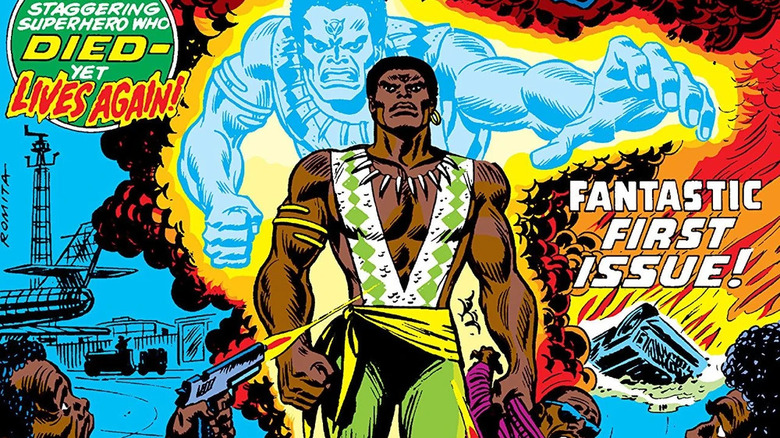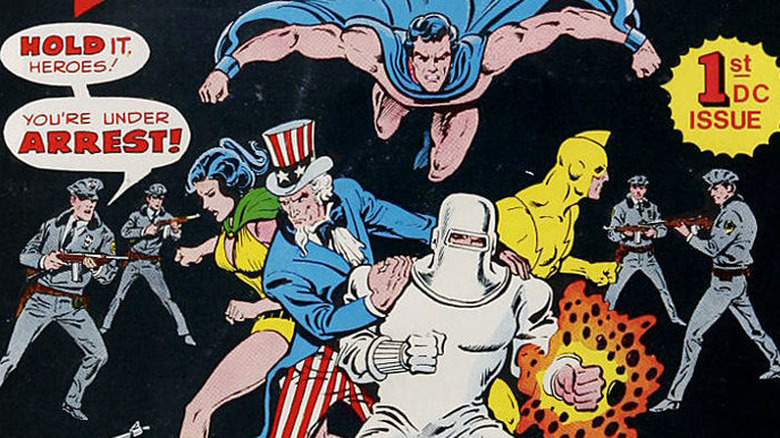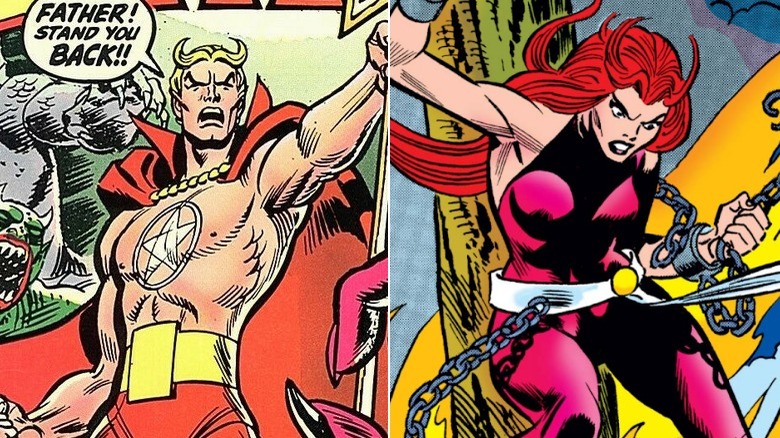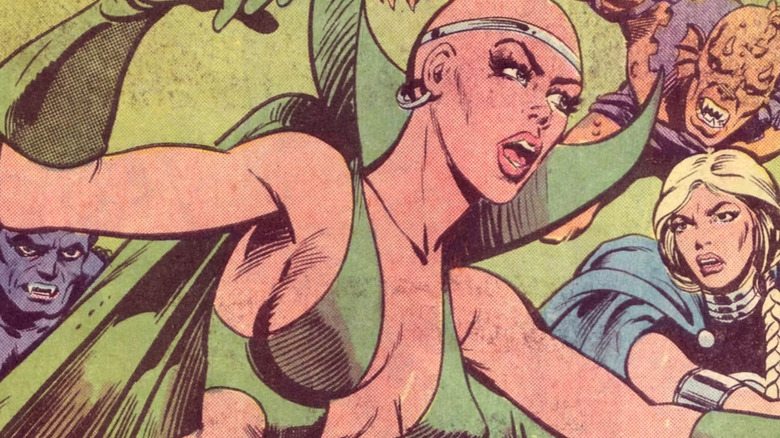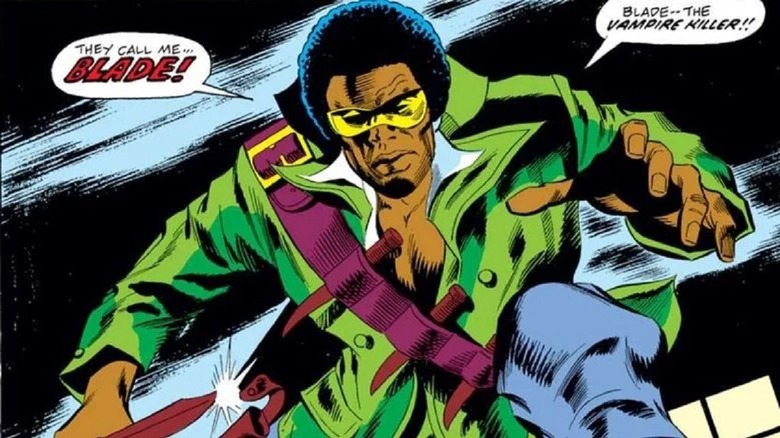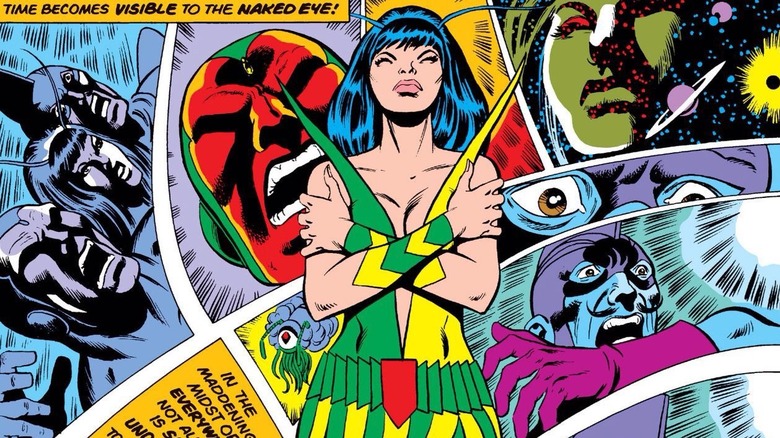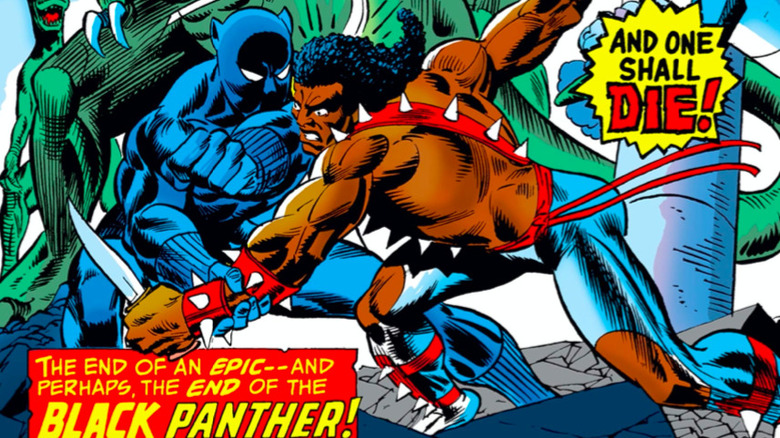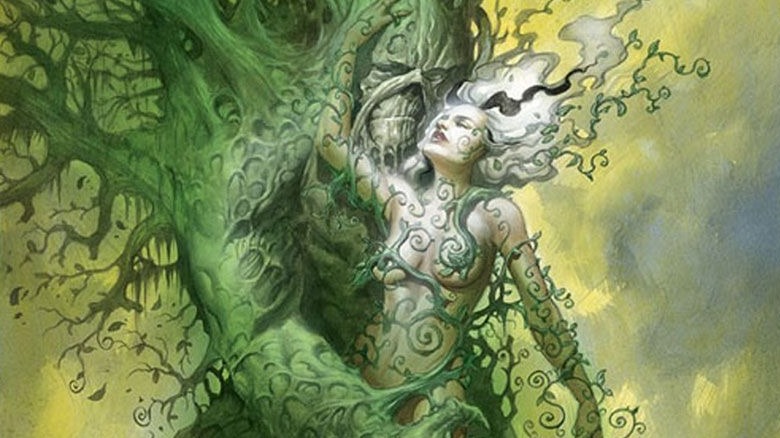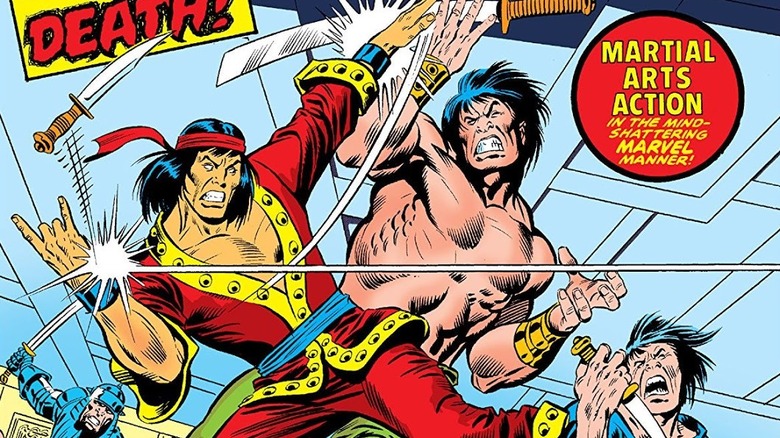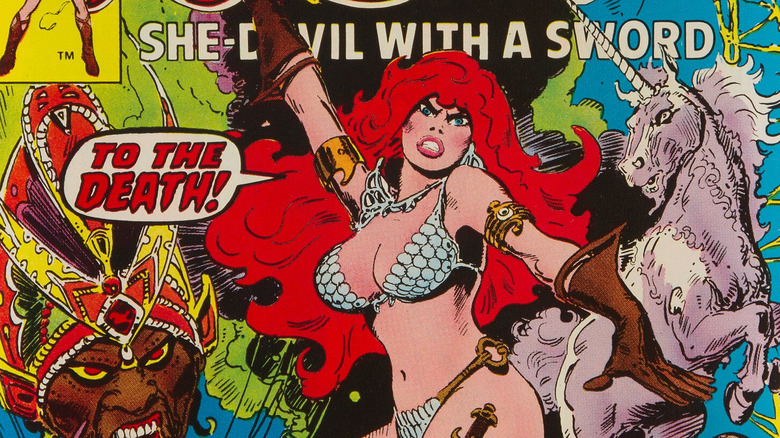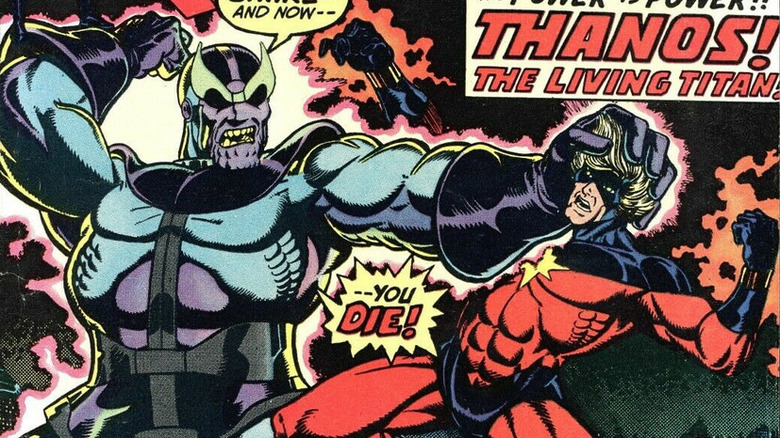Comic Book Characters Turning 50 In 2023
The 1970s were a big boom for comics. As readers of superhero titles from the '60s got older, the stories got more intense and began drawing on darker themes. The decade also saw a few big trends sweeping the stands, most famously via a rise in horror stories: vampires, werewolves, zombies, and other creatures of the supernatural. But the decade also saw a rise in cosmic heroes and villains as superhero stories didn't just take brief jaunts into outer space, but focused entirely on characters from across the galaxy.
The '70s not only saw the advent of Jack Kirby's "Fourth World" titles, but also planted the seeds for some of the genre's biggest interstellar heroes. This included the debuts of a number of characters you might recognize from some of today's biggest movies and TV shows, including "The Guardians of the Galaxy" and "The Eternals."
Audiences today might be surprised to learn just how old some of these characters are, debuting all the way back in 1973. But readers may also raise an eyebrow at just how different they originally were. From space-based tyrants to sorcerers and demons, let's explore some of the biggest comic book characters celebrating their 50th birthdays in 2023.
Starfox
"The Invincible Iron Man" #55 is a seemingly ordinary issue that sees the golden-plated Avenger in outer space, where he clashes with the villainous Blood Brothers. But the issue is far more famous for the first appearance of several major Marvel heroes and villains. Of course, readers couldn't know just how important they'd become at the time. We may as well start with Eros, better as Starfox today, the brother of Thanos. While he's been retconned as the pink-skinned Eternal in the years since, he was originally introduced as a purple-skinned Titan just like his sibling.
Readers learned later that Starfox possesses the ability to charm others and control their feelings. He also has the bizarre power to stimulate a person's pleasure center, putting them into a euphoric trance that acts like a love potion, which is how he got his name. This power has since become controversial because he's often used it to persuade others — both men and women — into romantic and sexual encounters.
In the 1980s, Starfox joined the Avengers, and more recently, the Dark Guardians. Over the years, he's battled the likes of Ultron, the Skrulls, and of course, his brother Thanos. In 2021, Eros entered the MCU, played by singer and actor Harry Styles.
If you or anyone you know has been a victim of sexual assault, help is available. Visit the Rape, Abuse & Incest National Network website or contact RAINN's National Helpline at 1-800-656-HOPE (4673).
Drax the Destroyer
Making a more notable first appearance than Starfox in "The Invincible Iron Man" #55 is the green-skinned Drax the Destroyer. Fans today know him from the "Guardians of the Galaxy" films, in which he's played by Dave Bautista. However, the character was very different in his debut. Clad in a purple leotard with a long flowing cape and cowl, he's barely recognizable as the same character.
Unlike his movie counterpart, this Drax is not an alien from outer space, but an artificial construct with the soul of a human named Arthur Douglas who was killed by Thanos. His spirit was grafted onto a new body by Titans who designed him as the perfect weapon to destroy Thanos. Not quite a hero, but not quite a villain, Drax later battled Captain Marvel and the Avengers but also sided with the good guys on various occasions. After Earth's assembled team of heroes defeats Thanos and Adam Warlock takes his Infinity Gauntlet, Drax is actually given possession of the Power Gem for a time as a member of the Infinity Watch.
Before being revamped as a tattooed alien killer in the 2000s, leading to his role in "Guardians of the Galaxy," Drax actually made his first on-screen appearance in the 1990s "Silver Surfer" animated series.
Howard the Duck
It may seem strange, but Howard the Duck is actually the first Marvel character ever to star in their own full-length, big-screen feature film. Not Spider-Man or Captain America or the Hulk, but Howard the Duck — a goofy, cigar-chomping, suit-wearing waterfowl who made his debut in a horror title called "Adventure Into Fear" of all places. The same book also featured stories involving Man-Thing, Morbius, and others, but Howard the Duck saw his first appearance in #19, written by creator Steve Gerber in 1973. His name wouldn't be revealed until "Man-Thing" #1 later that year.
A fan favorite for his off-the-wall adventures and jaded personality, Howard was later picked up by none other than Lucasfilm, eventually starring in his own movie in 1986. Since then, Howard has seen new life in comics and on the screen, with an adult-oriented title in 2002 and a reinvention as a private eye in 2015. He's since appeared in animation and on film, usually as a supporting character popping up alongside "The Guardians of the Galaxy."
Brother Voodoo / Jericho Drumm
In the 1960s, the anthology series "Strange Tales" featured the debuts of a number of Marvel mainstays, including Doctor Strange. That trend continued into the 1970s. Starting with 1973's "Strange Tales" #169, after Doctor Strange stopped being the central focus of the series, the next five issues were led by an all-new supernatural hero named Brother Voodoo. Created by Gene Colan and Len Wein, Voodoo was revealed to be Jericho Drumm, who returned to his native Haiti to find his brother Daniel dying, and took up the art of voodoo to battle evil forces.
Eventually, under the persona of Brother Voodoo, Drumm became a powerful sorcerer himself. He faced off against a number of mighty Marvel villains, including the evil organization A.I.M. Brother Voodoo also allied himself with the likes of Spider-Man, the Black Panther, and the Werewolf by Night.
In the decades since, Drumm has gained further notoriety by taking up the mantle of Sorcerer Supreme from Doctor Strange. After sacrificing himself in a battle with the powerful entity called Agamotto, Doctor Doom helped bring him back to the land of the living. Subsequently, Drumm saved the Avengers and X-Men from the wrath of the power-mad Scarlet Witch, and later joined the Avengers full-time.
The Freedom Fighters
Though 1973 was a huge year for Marvel debuts, rival DC Comics had a few notable new heroes show up too. While they never did become a premiere super-team like The Justice League or the Teen Titans, the patriotic-themed team The Freedom Fighters launched in 1973 in the pages of "Justice League of America."
During this era, the Justice League and Justice Society existed in parallel worlds, and they often traveled back and forth between dimensions for team-ups. In issue #107 of "Justice League of America," the team winds up mistakenly traveling to a third alternate Earth dubbed Earth X, where the Nazis won World War II. There they find a team composed of the world's only surviving superheroes: Uncle Sam, Phantom Lady, The Human Bomb, The Ray, Doll Man, and Black Condor.
Each of these heroes had previously appeared independently during DC's golden age across a number of different titles, but this was their first appearance as a unified team. In 1976, they got their own title, and they returned again in the 2000s in the aftermath of several reality-altering crossovers.
Daimon and Satana Hellstrom
The 1970s was an era marked by a rise in monster comics and the supernatural, largely thanks to the loosening of the Comics Code in 1971. Finally, stories about witches, vampires, werewolves, and the occult were no longer off limits, and Marvel took the opportunity to flood the stands with books about dark magic and hellish demons. Two major characters arrived in 1973, and though they're related, they debuted in different titles.
Daimon Hellstrom, the son of Satan, first appears in "Ghost Rider" #1. He's quite literally the spawn of the devil himself, but Hellstrom isn't quite a villain like you might expect. He actually helps Ghost Rider fight off a villain said to be possessed by his father in the comic. Later, he joins the ranks of the Defenders, and in more recent years he's even been an agent of SHIELD.
Over in the pages of "Vampire Tales" #2 – also from 1973 — came Satana, Daimon's sister. She went on to join the super-team called the Thunderbolts — later the Dark Avengers — but it was her 1970s incarnation that's perhaps most famous. Both Daimon and Satana were adapted into live-action in 2020 in the short-lived horror series "Helstrom" on Hulu, played by Tom Austen and Sydney Lemmon.
Moondragon
Another cosmic classic, the hero known as Moondragon debuted in the pages of "Iron Man" #54 (though she goes by the painfully on-the-nose moniker "Madame MacEvil" in that issue). First appearing in the issue right before the debut of her father, Drax the Destroyer, Moondragon started out as Heather Douglas, the daughter of the man killed by Thanos on his brief visit to Earth. Adopted by Thanos' father Mentor, she's brought under the care of an order of alien monks called the Shao-Lom.
Under their guidance, Douglas is trained to become an elite martial artist. But the monks also teach her how to bring out her secret psionic abilities, which are said to be possessed by all humans but remain untapped by most. Eventually, after defeating a being known as the Dragon of the Moon, she takes up the name Moondragon.
In the decades since, Moondragon has fought as a member of a number of Marvel super-teams, including the Avengers, the Defenders, and most recently the Guardians of the Galaxy. She has yet to appear in the MCU, but given her connections to Drax, Thanos, and the Avengers, it's probably just a matter of time.
Blade
From cosmic heroes back to horror and the supernatural we find Blade, the most famous vampire killer in comics. But that fame largely comes from the 1998 film adaptation starring Wesley Snipes, a film that helped kick-start the comic book movie boom. If you were to see the character in his first appearances in 1973, you'd hardly recognize him as the leather-clad, kung fu fighting killer Snipes portrayed.
Instead, back in the 1970s, Blade appears as a British soldier-of-fortune, wearing yellow goggles and a green trench coat with a bandolier loaded with wooden knives. As odd as he may look to us today, this Blade was no less deadly as a hunter of un-living bloodsuckers. His first appearance comes in "The Tomb of Dracula" #10, which sees him going right up against the Lord of the Vampires himself. But while Dracula survives the encounter (it is his book, after all), Blade would go on to become an iconic horror hero, eventually joining the darker side of the Marvel universe as the re-designed, black-clad hero we know today.
In addition to the Snipes films, Blade also received his own short-lived live-action TV spin-off and is being rebooted into the MCU with Mahershala Ali. He's also made animated appearances over the years in shows like "Spider-Man: The Animated Series," "Hulk and the Agents of S.M.A.S.H," and "Ultimate Spider-Man."
Mantis
Writer Steve Englehart and artist Don Heck were the creators of record on "The Avengers" in 1972 and 1973, and it was in the middle of their team-up that they debuted a new Marvel heroine called Mantis. She shows up first in "Avengers" #112 as a partner to The Swordsman, joining the team with him not long after. Gifted with an array of mental powers including telepathy, precognition, and astral projection, she becomes a powerful ally to Earth's Mightiest Heroes, joining them alongside Captain Marvel and Drax the Destroyer in their fight against Thanos, who'd acquired the Cosmic Cube.
Later, Mantis was revealed to be a powerful and ancient entity known as The Celestial Madonna in a sprawling, complex storyline that ran through several titles, involving everyone from Kang the Conqueror and Ultron to Agatha Harkness. Over the years, Mantis has been revamped a few times, and in the 2000s, following the "Annihilation: Conquest" storyline, she went adventuring with the Guardians of the Galaxy. It's thanks to that storyline that she eventually made her way to the big screen, joining the team in "The Guardians of the Galaxy Vol. 2" and beyond, played by Pom Klementieff. The MCU version of the character is reimagined as the adopted alien daughter of Ego the Living Planet.
Erik Killmonger
T'Challa the Black Panther may have been Marvel's first Black superhero, making his own debut in 1968 on the pages of "The Fantastic Four." However, he didn't actually receive his own comic book title until 1977. As a result, most of his biggest enemies made their first appearances in comics like "Jungle Action," the anthology in which Black Panther had most of his solo tales told. In "Jungle Action" Vol. 2 #6, from writer Don McGregor and artist Rich Buckler, the Panther's newest enemy arrives in the form of Erik Killmonger.
In the issue, Kilmonger is looking to take down Wakanda's king and steal the nation's vibranium. In his confrontation with the Black Panther, T'Challa is defeated and thrown over a waterfall — a moment adapted in the 2018 feature film "The Black Panther." Beyond his first appearance, Killmonger goes on to become one of T'Challa's biggest returning foes, making repeated attempts to usurp control of the African nation. In the MCU, he's played by Michael B. Jordan, and he was more recently re-envisioned in the Marvel comics to match the look of his on-screen counterpart.
Abigail Arcane
DC had its own revival of monster comics in the 1970s, most notably with the introduction of a new version of Swamp Thing in 1972. After the launch of his own title that year, creators Len Wein and Bernie Wrightson began fleshing out his supporting cast of characters, and in 1973, Abigail Arcane made her debut in "Swamp Thing" #3. Introduced as the niece of Swamp Thing's enemy Anton Arcane, Abigail is brought into the story when she's encountered by Interpol agent Matt Cable while he's investigating a string of murders, and the two fall in love.
Eventually, Abigail parts with Cable and falls for Holland, the Swamp Thing, becoming his longtime love interest. But Arcane is no ordinary woman. She's also a powerful psychic, and in the more recent reboot of the DC universe, she becomes the human host for a supernatural entity that transforms her into the deadly Black Queen.
Outside of the comics, Arcane has been on the screen several times. The 1982 film "Swamp Thing" co-stars Adrienne Barbeau as Abigail Cable, while its sequel sees Heather Locklear playing Abby Arcane, though neither is very faithful to her comic book counterpart. In 1990, she was played by Kari Wuhrer in a "Swamp Thing" live-action series, and in 2019, a new TV series featured Crystal Reed in the role.
Shang-Chi
Cosmic comics and monster stories weren't the only trends in the 1970s, as movies and TV held influence over the industry too. As a result, the popularity of Bruce Lee and martial arts movies came to the page, leading to characters like Iron Fist in 1974. A year before that, "Marvel Special Edition" #15 saw the introduction of another hero known as Shang-Chi, Master of Kung Fu. Created by Steve Englehart and Jim Starlin, he went on to star in his own title.
Over the ensuing decades, Shang-Chi was mostly a minor player in the Marvel comics, popping up from time to time as an ally of other martial arts mainstays like Iron Fist, Misty Knight, and White Tiger. He received a few of his own short-lived titles in the 1990s and 2000s, later joining the "Heroes for Hire" series.
But while Iron Fist was arguably the most popular martial arts hero in the Marvel universe for decades, that has begun to shift in recent years. Thanks to the poor reception to Netflix's "Iron Fist" series and the critical acclaim of the MCU's "Shang-Chi and the Legend of the Ten Rings," the Master of Kung Fu is finally getting the respect he deserves. In 2022, he received a new ongoing series, "Shang-Chi and the Ten Rings."
Red Sonja
Some of Marvel's biggest hits in the 1970s weren't even the company's own characters, but rather figures from licensed comics like "Rom: Space Knight." One of Marvel's best sellers in the era was "Conan the Barbarian," the sword-and-sandal hero created by Robert E. Howard who'd been the subject of countless pulp novels (per CBR). Naturally, Marvel wanted to capitalize on the success of the Conan comics, so it turned to another Howard creation, Red Sonya, and brought her into Conan's world as the fearsome swordswoman Red Sonja.
First appearing in "Conan the Barbarian" #23 by Roy Thomas and Barry Windsor-Smith, Red Sonja was every bit the warrior you'd expect. After headlining "Marvel Feature" in 1975, she quickly got her own comic book series, "Red Sonja: She-Devil with a Sword." That series ran for 15 issues through 1979 and was revived for two more in 1982, before getting a bi-monthly revival the following year that ran for almost two years. Decades later in 2005, the character was brought back by Dynamite Comics, and the company has run with the character since.
Thanos
"The Invincible Iron Man" #55 features a bevy of first appearances, from major future players like Drax and Starfox to lesser-knowns like Kronos and Mentor. But without a doubt, the issue's biggest debut was Thanos, the Mad Titan who would ultimately become one of the biggest villains in the Marvel universe. At the time, he was portrayed as a powerful demi-god of sorts, but not nearly the despotic, nihilistic tyrant he is today.
Not long after his first introduction, Thanos became the nemesis of Captain Marvel and acquired the Cosmic Cube in a quest for galactic domination. He soon became a perennial foe of the Silver Surfer, while his next quest for cosmic control saw him assemble the Infinity Gems. That story culminated in the 1991 mini-series "The Infinity Gauntlet," which firmly established him as Marvel's most dangerous cosmic threat.
Since then, Thanos has had countless encounters with the Avengers, the X-Men, and the Guardians of the Galaxy, assembling his own group of minions called The Black Order in his showdowns with them. Of course, he also came to mainstream prominence when he was teased in the 2012 blockbuster "The Avengers," before taking the central villain role in two of the biggest movies of all time – "Avengers: Infinity War" and "Avengers: Endgame" — played by Josh Brolin. But Thanos' legacy started back in 1973, in a humble issue of "The Invincible Iron Man," changing both the comic book and movie industries forever.
